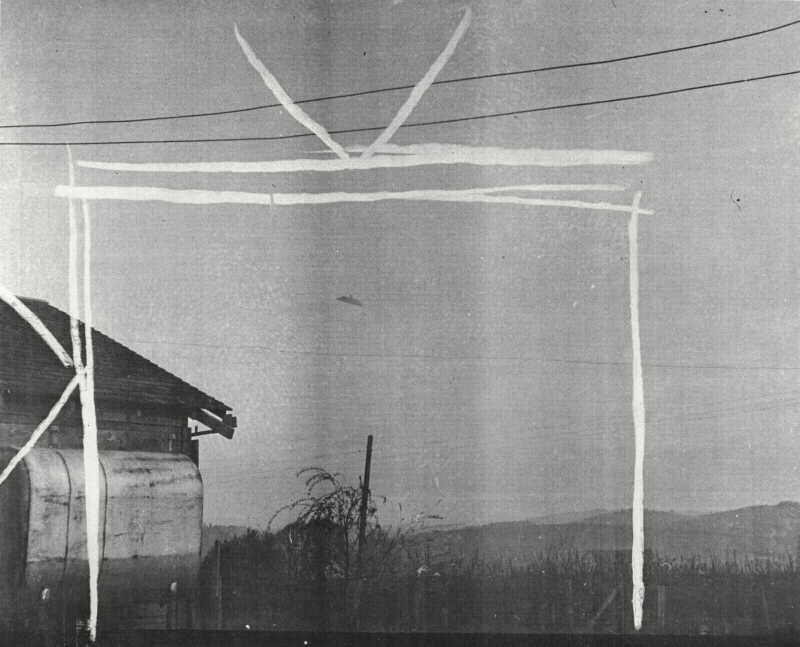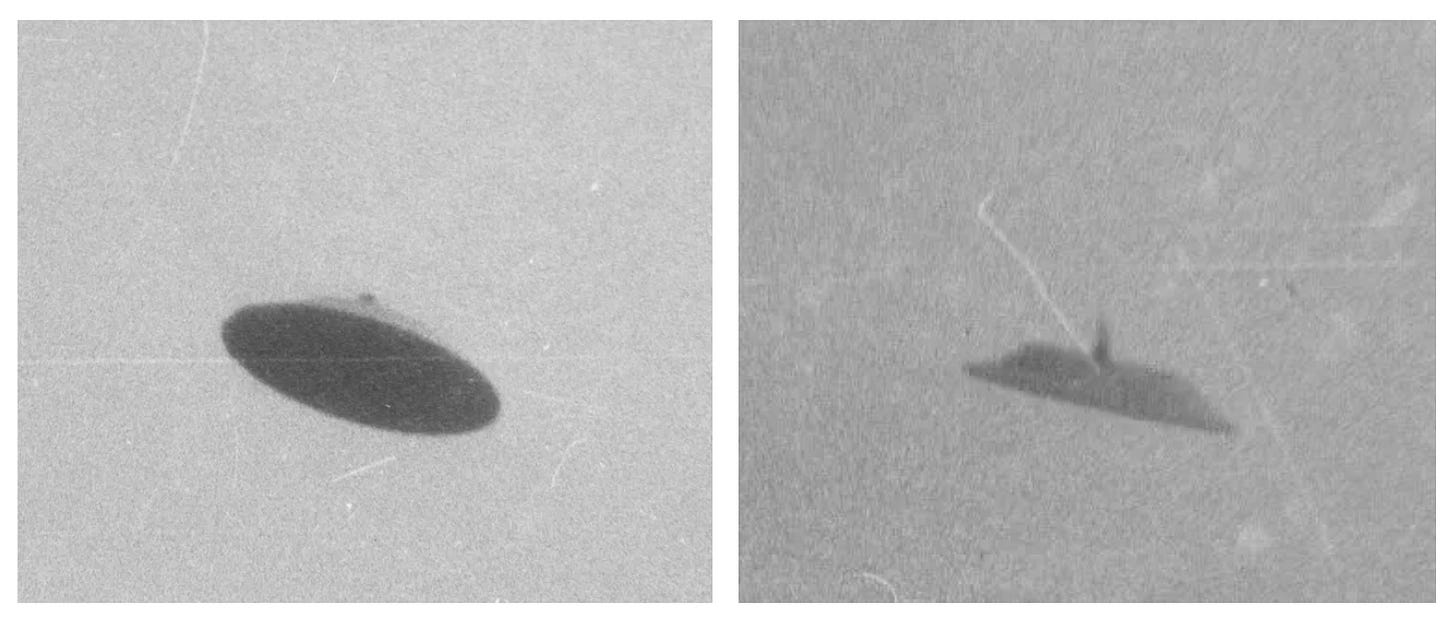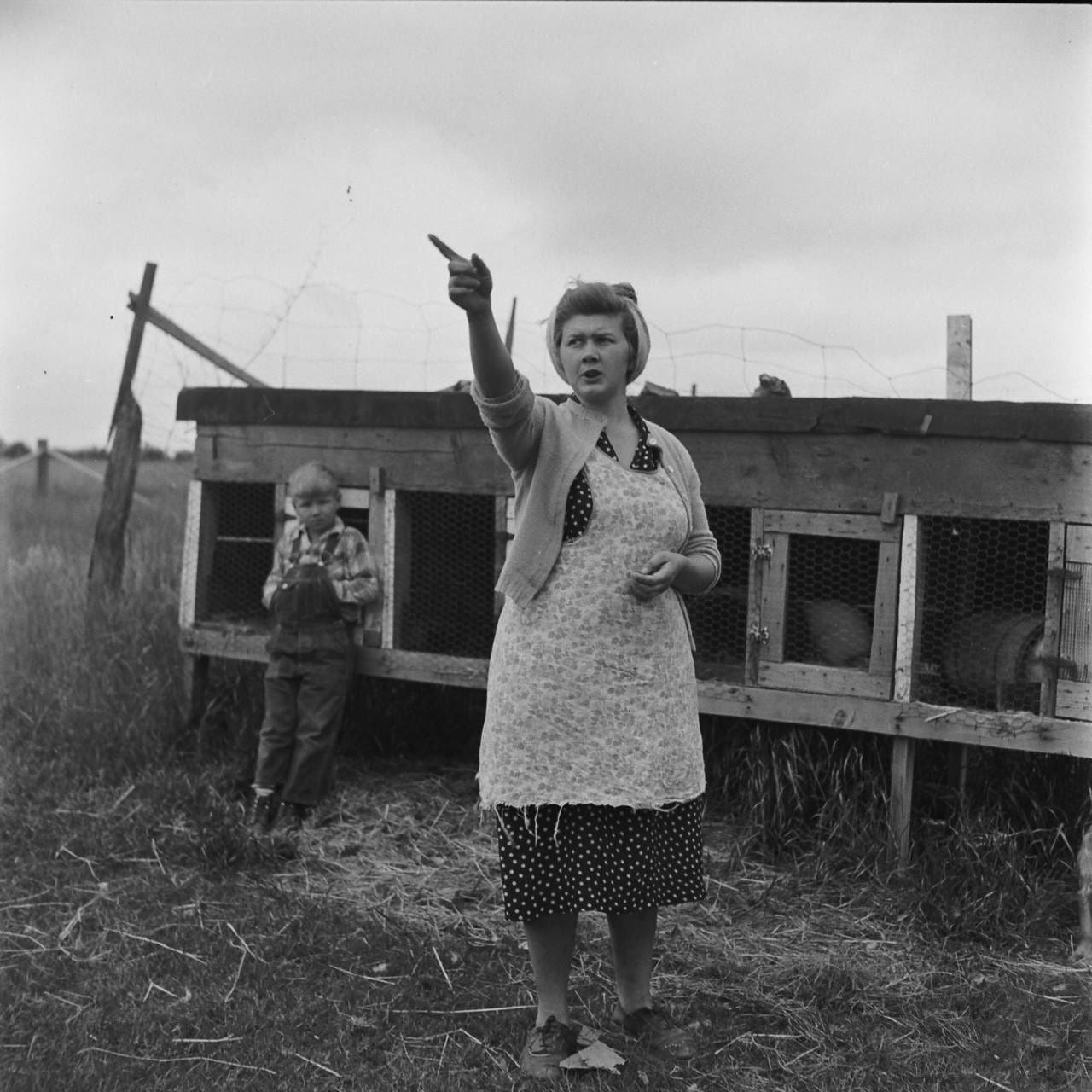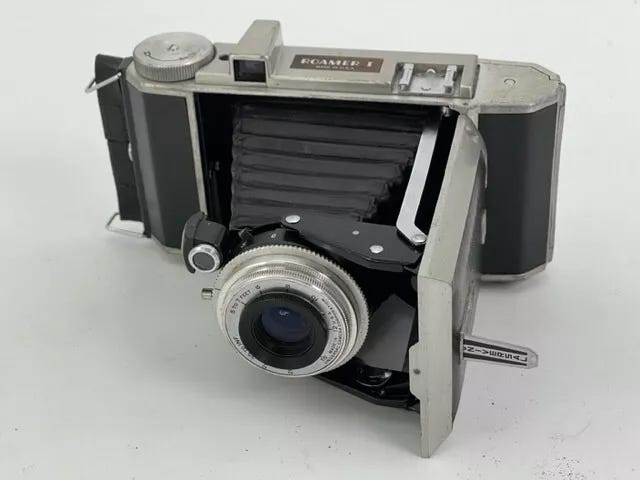The Trent UFO Photographs
"It was as pretty as anything I ever saw."
May 11, 2025 marks the 75th anniversary of two of the most important images ever captured by human beings. I refer to the photographs taken by Paul and Evelyn Trent of what appears to be a flying saucer as it passed their Oregon farm one fine evening in 1950. At the time, the photographs were the best published of a UFO.
Each photograph provides valuable information, capturing the object as it changed position and orientation while moving through the sky. In the first, the top part of the object is tilted away from the camera, revealing a round, flat base. Just a tip of the top “mast” appears over one edge. In the second photo, the object is seen more from a side profile. The view shows what then reporters called “what appears to be a superstructure” and a “submarine conning tower” on top.
The object appears to be artificial, metallic, disc-shaped and flying by means that contemporary scientists have been unable to explain. The detail, sharpness, definition, high contrast, and proper exposure of the film during difficult circumstances add up to make them stand among the best photographs ever taken of UAP, three-fourths of a century after they were made.
Surprise, then a Call to Action
“I was out feeding the rabbits and checking the henhouse for eggs,” Mrs. Trent said. “As I was coming back to the house, I happened to look up and I saw this thing and I ran into the house to tell Paul about it. He went after a camera, and I went another way after a camera, and between the both of us, we found it.
“It was like a good-sized parachute canopy without the strings, only silvery bright mixed with bronze. It was as pretty as anything I ever saw.
“It was all flat on the bottom. There was no smoke, no noise either way. It was just above the electric light wires. The distance and stuff, I just don't know. It basically hovered for a while just like that and he took the picture. Just as soon as he took the picture, he wound the film – to re-roll, to take another one – and as soon as he took it, it turned and just took off very fast.”
“It was as pretty as anything I ever saw.” — Evelyn Trent
“I was kind of scared of it,” Mr. Trent said. “You know, you hear so much talk about those things and the government. I didn't believe all that talk about flying saucers before, but now I have an idea the Army knows what they are.”
What the Eye Saw Matches What the Camera Caught
Paul Trent said the unidentified object appeared about 20-30 feet in diameter and moved slowly and silently at first. He managed two photos before it darted off. The entire episode took about 30 seconds.
“The object was coming in toward us and seemed to be tipped up a little bit,” Mr. Trent said. “It was very bright -- almost silvery -- and there was no noise.
“It seemed to be both dark and silver. There wasn't any flame, and it was moving fairly slowly…Then I snapped the first picture. It moved a little to the left, and I moved to the right to take another picture. Then it seemed to pick up speed suddenly, and in no time at all, it vanished out of sight.”
Mr. Trent estimated that the object was about a quarter-mile from him. He said he was unable to estimate its altitude. He also supported his wife’s observation that they felt a sudden and brief gust of wind as the craft quickly and silently departed. The time was about 7:30 p.m.
“I was kind of scared of it,” Mr. Trent said. “You know, you hear so much talk about those things and the government. I didn't believe all that talk about flying saucers before, but now I have an idea the Army knows what they are.”
The images have undergone extensive analysis, almost as much scrutiny as the Trents endured. The United States Air Force commissioned Dr. Edward U. Condon of the University of Colorado to lead a scientific study on UFOs. Conducted from 1966-1968, the final report concluded the formal study of UFOs would not yield much useful science. However, the Trent photographs posed a dilemma.
“This is one of the few UFO reports in which all factors investigated, geometric, psychological, and physical, appear to be consistent with the assertion that an extraordinary flying object, silvery, metallic, disk-shaped, tens of meters in diameter, and evidently artificial, flew within sight of two witnesses.” – The United States Air Force-University of Colorado Study on UFOs.
The Trent farm was located outside Sheridan, in northwest Oregon, about nine miles from McMinnville. The area is about 30 miles east, as the saucer flies, from the Pacific Ocean.
At the time of the sightings in 1950, Mrs. Trent was 28 and Mr. Trent was 43 years of age. The couple had married in 1943 and were raising a family that would include five children. Neighbors, friends and members of the Sheridan and McMinnville communities vouched for the integrity of Mr. and Mrs. Trent and held them as people of good character who kept their word.
Sharing the Truth
The two Trent photographs caused a sensation in the press when first published in 1950. From the local paper in McMinnville to the major dailies in Portland and from there flashed by AP Wirephoto around the globe, the front pages shocked the public with what were then the first sharp, detailed and well exposed photographs of a flying saucer.
Even though the notoriety of taking the images of a UFO put their lives in an uproar, Mr. and Mrs. Trent never changed their story. Nor did they take or make money from the photos. In fact, rather than putting the negatives in a bank safety deposit box, the Trents freely shared their story and images with whoever wanted them.
The original negatives are priceless in terms of the data they contain. Objects on the film can be analyzed for size, distance, brightness, and measured in many other ways that reveal information and expose fakery. Today, digitization and computer analysis can reveal even more about the object and its circumstances, pixel-by-pixel.
When it came to the original photographs and negatives — and the story behind them — Mr. and Mrs. Trent were most kind and generous. Recipients of their generosity included a number of major news organizations and personalities, as well as uncounted official and private UFO investigators and organizations. Many, if not most, of these agents and agencies did not put the interests of the Trent family ahead of their own agendas.
The negatives themselves were in the possession of others for decades after they were created. Today, covered by scratches and other marks, the negatives look like many hands shared them. One oft-published enlargement is marred by a thumbprint.
Mrs. Trent died in 1997. Mr. Trent died in 1998. While Mr. and Mrs. Trent never profited from their amazing photographs and international fame, they always stuck by their original story of what they experienced.
A Universal Camera
Based on the images of Mr. Trent posing with the camera, I agree with UFO researchers who report he used a “Roamer 1” camera, designed and manufactured by the Universal Camera Corporation of New York.
Capable of using both 120 and 620 roll film, the Roamer 1 produced six negatives sized 2 ¼ by 3 and ¼ inches per roll. Typically, larger negative sizes will yield sharper enlargements when using a lens of similar quality.
The Roamer 2 model, equipped with a more advanced lens and a shutter with several exposure speed settings, retailed for $40. The Roamer 1 camera would retail for less, possibly around $30 in 1949, approximately $400 in today’s dollars.
Here what the Universal Roamer owner’s manual says about the cameras:
The versatility of these folding cameras makes them ideal for the photo fan who requires a highly effective camera, yet one which is easy to carry and easy to use. Our Design Engineers have developed these precision picture-taking instruments, which require only a minimum of adjustment on the part of the camera user. The exacting construction, and the many built-in features make these Roamer cameras outstanding recorders of family, friends, and other "kept-for life" events.
I wholeheartedly agree with Universal’s assessment of their camera. In the hands of Paul Trent, the Roamer preserved a most unusual phenomenon for history.
A Gifted Lensman
Skeptics today are prone to ask, why, in an age where most everyone owns a camera in the form of their Smartphone, are there “no good UFO photographs?” Rather than my gut reaction to ask, “Do you know when and where a UFO will appear?” I ask, “Have you heard of Paul Trent?”
Getting a good shot in 1950 was a lot more complicated process than today. To take the famous photos, Mr. Trent first set how much light passed through the lens, adjust the focus, and frame the image. To take a sharp picture, he had to breathe in, stand rock steady and gently press the shutter release. Afterward, he rolled a knob to advance the film a precise number of turns, and repeated the process — all in about 30 seconds.
Not many people could produce good pictures then or today under the best of circumstances. Paul Trent also kept his wits during a most demanding situation when facing something that looked like it came from another world.
The Result
Mr. and Mrs. Trent never sought publicity for their photographs. Moreover, while they wondered what they showed, the Trents never claimed what they photographed came from outer space, was a flying saucer or a UFO. That term, for Unidentified Flying Object, would be coined by the U.S. Government later, in 1952.
They saw something in the sky near their home that they could not identify and maintained the presence of mind needed to photograph it in the few moments available. The two photographs have since been examined by experts, skeptics, critics and the public and they are deemed to be true and authentic.
What Eveyln and Paul Trent reported they saw was recorded by their camera. The images taken 75 years ago are still to this day among the best images ever taken of what’s called in today’s official parlance, Unidentified Anomalous Phenomenon.
What’s more, the Trent photographs enable us to share in a surreal experience that otherwise could be lost to history and memory. Thanks to Evelyn and Paul Trent, we also enjoy the privilege of seeing what appears to be an actual flying saucer.









